On Wednesday 26th October 2005, my friend Mike and I made our first excursion onto the single line from Kolomiya to Rakhov. We found out how our hosts had dealt with the problems of 24th October when Er797-86 had got into trouble, short of steam, on the Rakhov line (mentioned in Part 2). The solution adopted was to subsequently double-head the train, with Er797-86 coupled tender to tender with Em735-72. Er 797-86 (chimney leading) would haul the train out from Kolomiya with Em 735-72 (tender first) assisting as required. After running round both engines coupled together at the far end, Em 735-72 (now chimney leading) would return the train to Kolomiya with assistance from Er 797-86.
'E' class background
The 'E' class 0-10-0 had been introduced in 1912 as a development from the earlier 'O' series 0-8-0. Russian-built 'E' class were supplemented in the early 1920s by imported 'E' class from Germany and Sweden. The 'Eu' class was a Russian redesign built in large numbers from 1926 until the 'Em' was introduced in 1931. Modifications to the 'Em' design produced the 'Er' class, more powerful and economical than the 'Em'. This class was built between 1935 and 1957. Altogether over 11,000 of the various types were built. There's a little more information on the class here.
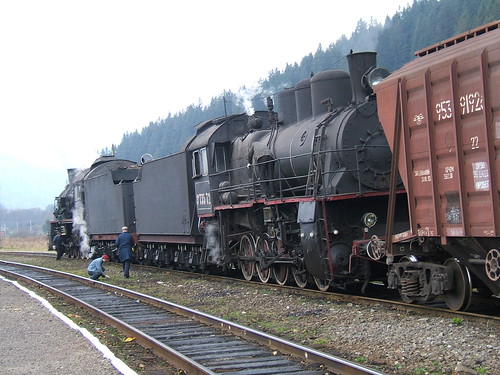 Er 797-86/Em 735-72 stand at Mikulichin.
Er 797-86/Em 735-72 stand at Mikulichin.
A journey into the Carpathian Mountains
Although the organisers had initially hoped that we could travel to Rakhov, in fact we were only allowed as far as Vorokhta (about 90 km from Kolomiya).
On the first leg of the journey out, Mike and I were allocated to Em 735-72, which we'd been on for our first day's driving (described in Part 2). We departed from Kolomiya heading west with a train comprising bogie hopper, bogie open and bogie flat wagons. About 47 km from Kolomiya, we arrived at the junction station at Delyatin, where a direct line from Ivano Francovsk converges. Delyatin had a most impressive station building but only the very narrow, low platforms common at smaller stations.
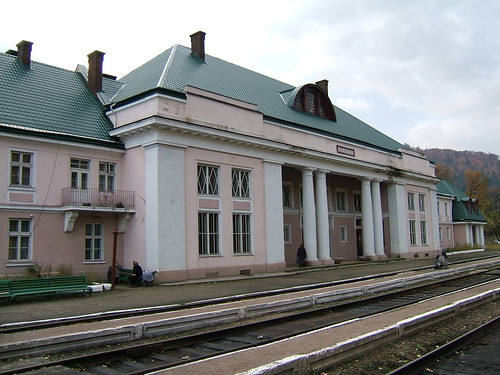 The impressive station building (and narrow, low platforms) at Delyatin.
The impressive station building (and narrow, low platforms) at Delyatin.
A handful of passengers were waiting and our train stood at Delyatin for about half an hour until a diesel multiple unit travelling in the opposite direction cleared the line ahead.
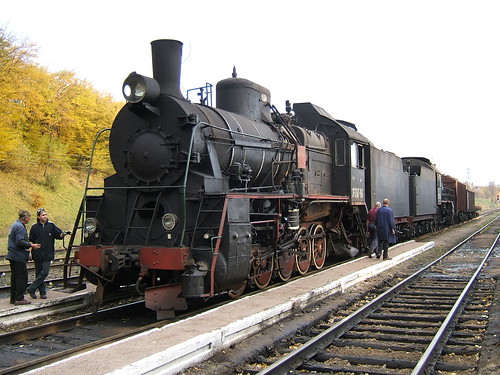 Er 797-86/Em 735-72 pause at Delyatin.
Er 797-86/Em 735-72 pause at Delyatin.
As we continued, the scenery became far more rugged as we headed into the forest-covered mountains. The picture below shows the view ahead of the train, looking from the footplate through the aperture in the tender cab (Em 735-72 was travelling tender first).
 View ahead from Em 735-72.
View ahead from Em 735-72.
The above picture also gives a clue regarding the steaming problems. The coal in the tender was very small pieces - slack. Worse, the dust which accompanies slack had been lying in the tender, exposed to the rain, for goodness knows how long, turning the dust to mud which had then dried like cement. We'd not had major problems on our trip to Stefaneshty or with the Su251-86 on the fairly level route to Chernivtsi, but the route to Rakhov was clearly more demanding. In addition, the amount of ash we'd seen dumped by Em 735-72 at Stefaneshty and by the Su251-86 at Chernivtsi suggested that it wasn't a high grade coal to start with. A good coal for locomotives should have a high calorific value, low content of incombustible ash and low content of harmful elements like sulphur which can produce an 'acid rain' attacking the boiler tubes.
8 km beyond Delyatin, we passed through Yaremcha which is an important tourist centre, with a modernised station. The year following my visit, the Romanised spelling of the name was changed to 'Yaremche' (see Wikipedia here). After a further 10 km, we stopped at Mikulichin, where we had to wait for a 'path'. Mikulichin was as pretty a village as the website here suggests and we spent some time exploring the minor road through the village before returning to the fairly isolated station.
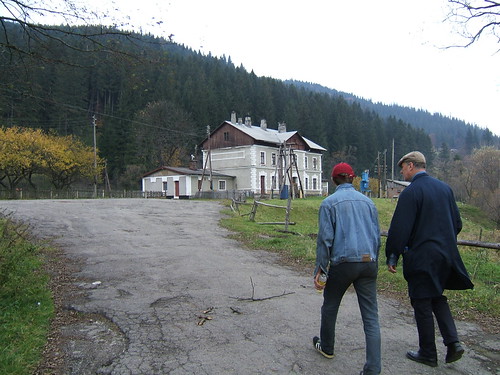 Station approach, Mikulichin.
Station approach, Mikulichin.
Back at the station, the friendly lady stationmaster allowed me to study the signalling and telecommunications facilities. I'll describe what I was able to glean in a later post. After a wait of around two hours at Mikulichin, we finally had our 'path' to enable us to set off on the remaining 16 km to Vorokhta. For this leg, the eight trainees had swopped engines, so Mike and I were now on the leading engine, Er 797-86, again taking it in turns to drive.
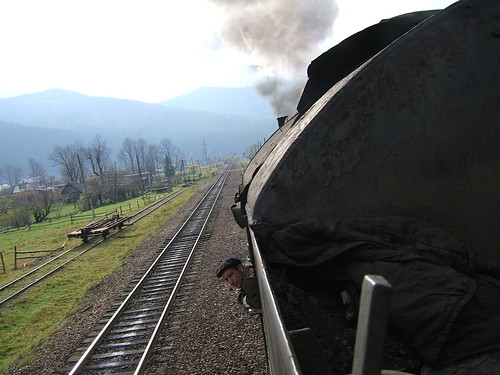 Er 797-86 leaving Mikulichin.
Er 797-86 leaving Mikulichin.
Approaching Vorokhta, we passed over a fairly notable modern viaduct. There were sentry boxes at each end, presumably from the Soviet era, but they appeared to be no longer in use.
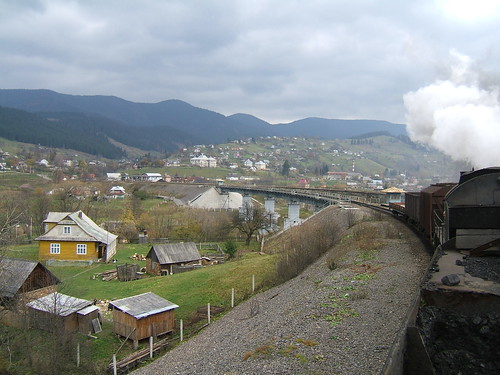 View from Er 797-86: looking back, approaching Vorokhta.
View from Er 797-86: looking back, approaching Vorokhta.
At Vorokhta, the two locomotives were detached from our train and, coupled together, run round our three wagons ready for the return journey. There was then a 'photocall' as everyone (bar the photographer) posed in front of Em 735-72 as pictures were taken with various cameras.
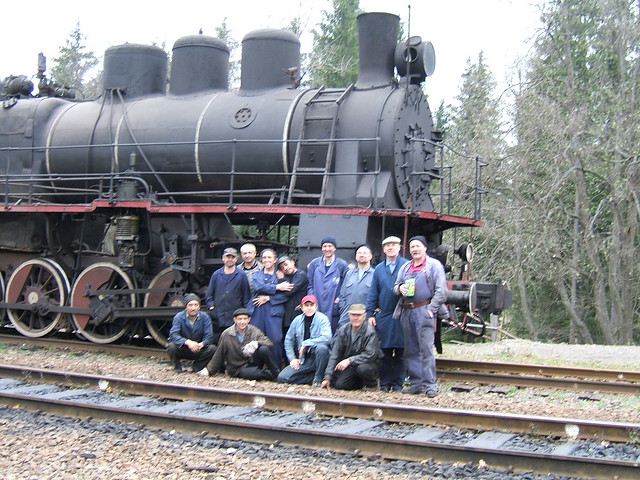 Em 735-72 and the entire cast pose for photographs.
Em 735-72 and the entire cast pose for photographs.
The Ukrainian crews then invited us to lunch on the footplate of Er 797-86. A wooden table appeared from somewhere and lots of typical Ukrainian food was handed round. It was a very jolly interlude.
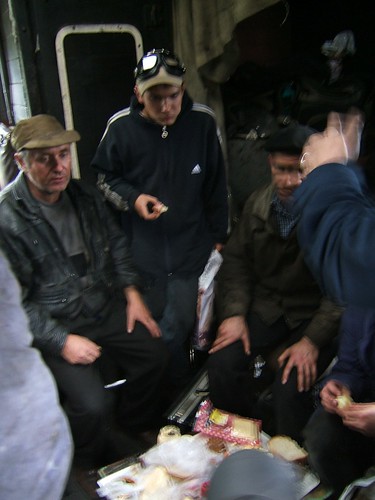
Er 797-86: Lunch on the footplate at Vorokhta.
We set off on our trip back to Kolomiya having swopped round again so that Mike and I were once again on Er 797-86. The picture below gives a good idea of the attractive area we were passing through. The train is about to pass over one of the many ungated road crossings. Notice the open wire pole route for telephones.
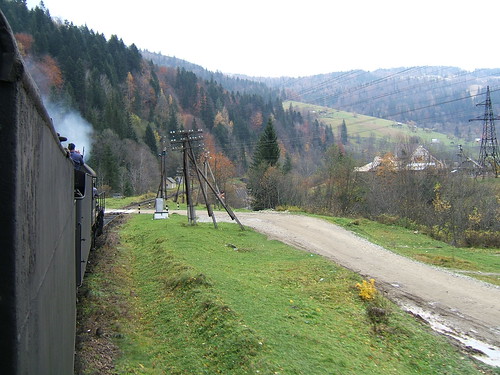 View from Er 797-86 returning from Vorokhta.
View from Er 797-86 returning from Vorokhta.
I'm afraid I'm unclear exactly which bits of the line I drove personally, but I do remember driving through the tunnel on this line. I usually drive with the sliding side window of the cab (which the Russian locomotives also have) open. Approaching the tunnel, I deemed it wise to slide it shut. The tunnel wasn't a 'tight fit' so conditions weren't bad but there was plenty of steam swirling around the cab. We were on the leading engine, of course, so I don't know whether matters were less comfortable on Er 797-86 behind us!
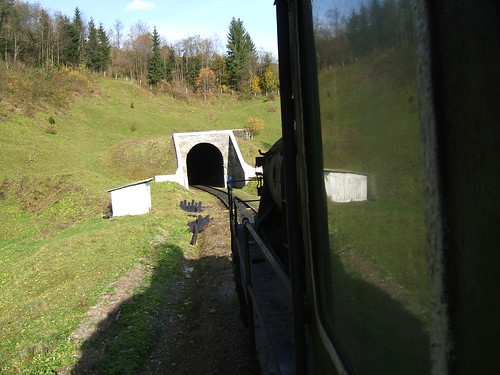 Fireman's view of the tunnel from the cab of Em 735-72 en route to Kolomiya.
Fireman's view of the tunnel from the cab of Em 735-72 en route to Kolomiya.
The last pictures I took on that day were at Yaremcha. By the time we arrived back at Kolomiya, we'd had an interesting but tiring day. The following day would be our last driving day, and that's described here.
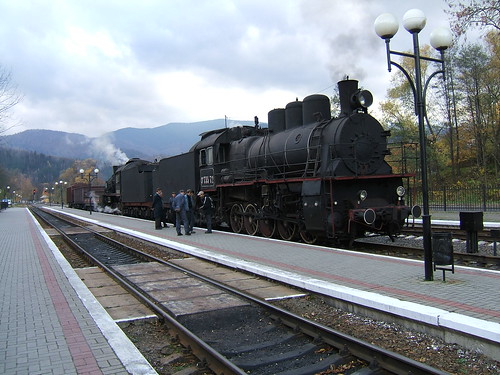 Er 797-86/Em 735-72 at Yaremcha.
Er 797-86/Em 735-72 at Yaremcha.
Russian Railway background
At the time of my visit to Ukraine in 2005, I was almost completely ignorant about Russian Railway practice. The book 'Soviet Locomotive Types - The Union Legacy' (reference [1] below) is an invaluable primer on Russian steam, diesel and electric traction. In 2011, a river cruise from Moscow to St. Petersburg (described in a series of posts here) gave me tantalising glimpses of railways in Russia. Then, in 2011, I travelled by the 'Golden Eagle' private train from Ulaan Baatar to Moscow (described in a series of posts here).
Book References
[1] 'Soviet Locomotive Types - The Union Legacy' by A J Heywood & I D C Button (Frank Stenvalls Forlag) ISBN 0-9525202-0-6.
Photographs
The railways:
Ukraine Steam.
The country:
Ukraine.
